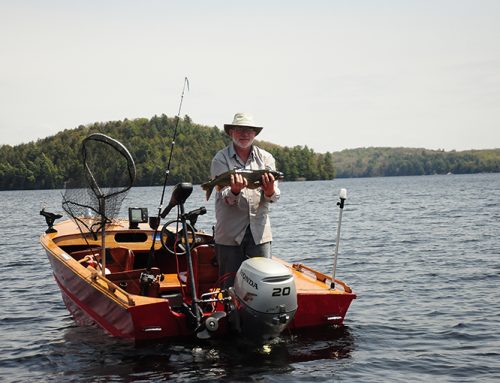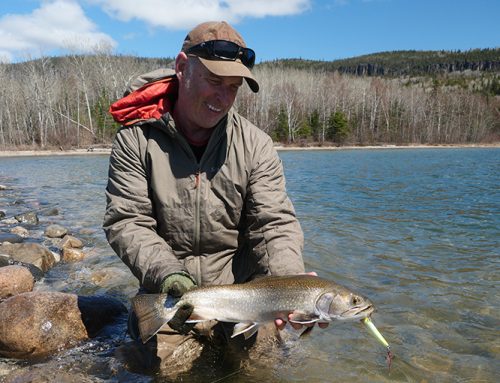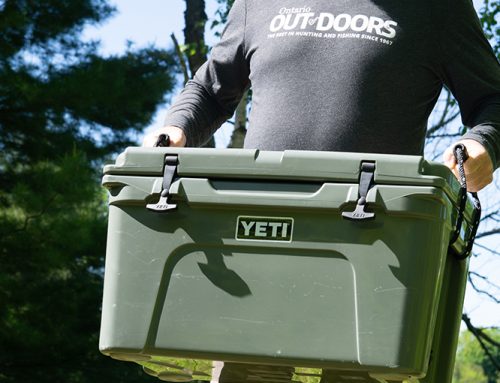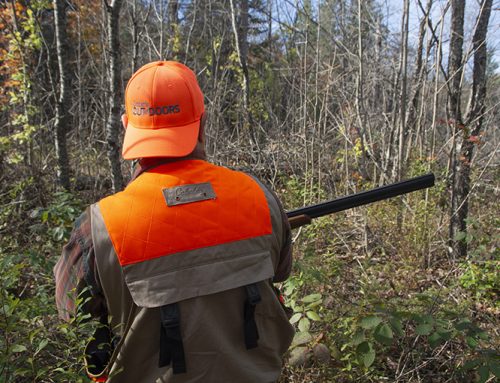No trout vest or tackle pack is complete without a selection of proven hardware. Even a casual observation of the offerings that take the province’s top trout will place lures at the top of the list of fish catchers. But there are baubles that catch the eye of an angler in a tackle shop and then there are those that are proven fish foolers when passed below the surfaces of our rivers and lakes.
The following 10 categories are the gold that we separate from all the glitter. The complete trout angler should have a few carefully selected entries from each.
1. Weighted-body spinners
Weighted spinners were around long before the Mepps Aglia was introduced to Canada in 1938, but that event started a revolution in spinner design. Today, Brecks still offers a selection of castable spinners, but other manufacturers offer great ones too, such as Blue Fox Vibrax, Double Loon, Panther Martin, Worden’s Rooster Tail, EGB, and Strike King. Pick a size, weight, blade design, and colour in any of these brands to match your trout-fishing needs.
Knowing spinner basics allows you to make good choices no matter where you fish. Small-stream specks call for tiny lightweight spinners. Long-distance casting for big trout in deep rivers and lakes requires a mid-size spinner with a heavier body. Rounder blades spin most easily at slower speeds and help a spinner ride just off bottom and snags, a must for shallow river fishing. A narrow willowleaf blade runs deeper at faster speeds, making it a good choice for trolling. The slightly oblong “French-style” blade is still a popular compromise. Metallic and dark blades excel in clear water, bright finishes in low-visibility water.
2. Trolling spinners
Trolling weighted-body spinners is one option, but there are others, usually multi-bladed. On-line snelled walleye-style spinners or straight-shaft unweighted tandem willowleaf spinners in gold or silver, tipped with a piece of worm, work wonders for specks and rainbows. Put a minnow on the hook for lakers. These spinners include the Williams Firefly, Hildebrandt, and EGB Tandem.To prevent brutal line twist, use a quality ball bearing swivel when trolling spinners.
Large gang-trolls, popular for lake trout, have a number of blades, a rudder at the front to prevent line twist, and a snap-swivel or clip at the back. They’re said to resemble a school of baitfish to draw in trout. A lure such as Flatfish or Spin N’ Glo is sometimes attached to the back of a gang troll, but a minnow is most effective.
An almost forgotten trout lure for deep trolling is the weight-forward spinner, typified by the Erie Dearie. Again, sweeten it with bait.
3. Wobbling “banana” plugs
When trout refuse everything you throw at them, break out a wobbling plug and let it work its irritating magic. They wobble lazily, even at a near-standstill. A slight increase in retrieve speed gives them a frantic action. No wonder that a stop-and-go retrieve is often deadly.
Flatfish and Kwikfish are the lightweights in this category, making them ideal for shallow river fishing. Add split-shot for weight on the line as needed for casting distance or to work deeper. Mid-weight lures in this class include the Beno, Tadpolly, and Lazy Ike. They’re good choices for big trout in deep rivers, casting from piers, and trolling. All of these lures can be used for any trout. Fussy specks can be teased into striking by adding a piece of worm on the hook of a small model. A wide variety of finishes is available to match local preferences of any trout. Bright colours, especially fluorescents, take big migratory trout. Black with metallic specks and “skunk” finish are tops for clear-water steelhead.
4. Crankbaits
From deep-divers that probe 20 feet(6 m)down to lipless rattle lures, there’s a crankbait for every trout-fishing situation. The No. 5 Shad Rap is a good all-around lure for lakes or medium to large rivers. In the spring, troll a perch or fire tiger model for rainbows and specks, or a natural or silver one for browns and lakers.
When lakers and splake are shallow shortly after ice-out, lipless cranks like the Rattle Trap or Luhr Jensen Sugar Shad are tough to beat. In deeper lakes or for back-trolling in large rivers, a 3/8-ounce Berkley Frenzy Medium Diver, Excalibur Fat Free Shad, Salmo Butcher, or a Rebel Crank-R will get you a bit deeper. These slightly heavier cranks also cast well and are trout candy when pumped over reefs or along dropoffs. For lake trout and rainbows in late spring and early summer, trolling a heavy crank like a 3/4-ounce Magnum Storm Hot N’ Tot will get you down to about 12 feet(3.6 m). Braided or fused superlines work well with crankbaits, but make sure you have a rod with some give in the tip or fish will pull off.
5. Casting spoons
The classic casting spoon is indeed spoon-shaped, compact, and weighs between 1/4- and 5/8-ounce. It can represent a range of baitfish, depending on its finish. The list of casting spoons is long, but a few standard bearers are the Little Cleo, Gibbs Koho, EGB Blinker, Delfin Alligator and Krocodile Stubby. All of them have a wide wobble and flash that trout of all stripes find irresistible.
While fat-bodied spoons cast well and are easy to fish, some steelheaders prefer longer spoons like the Luhr Jensen Krocodile, Gibbs Croc, and Mepps Syclops. Their action is tighter, which seems to have a special appeal to cold-water rainbows.
Jigging spoons are often overlooked for open-water situations, except for vertical jigging. Most jigging spoons have little curvature and therefore no action on a steady retrieve. They come alive, however, with a jerk-and-pause retrieve. Cast the spoon out, let it sink, pull the rod tip to the side, and reel up slack. Popular makes include the Hopkins, Swedish Pimple, Gibbs Minnow, Zzinger, and Crippled Herring.
6. Trolling spoons
In spring and fall, you can also flat-line with heavy casting spoons for any trout that feeds on baitfish, smelt, or cisco. When downrigging or wire-lining, however, the fluttering action of thin-bodied spoons like the Williams, Fishlander, Luhr Jensen Diamond King, Gibbs Gypsy, Nasty Boy, Northern King, and the like pay off. The plastic Apex spoon, which is rigged on a monofilament leader, offers a slower trolling presentation, but is dynamite on lake trout and rainbows. Attach spoons to the line with a simple, but strong, snap. There’s no need for a swivel. If the spoon is spinning, you’re trolling too fast for it to work effectively. Check the action of a spoon near the surface before dropping it down to fish.
7. Shallow-running minnows baits
Trout eat minnows, so it’s no surprise shallow-running minnow baits are so effective. Whether trolled at depth from a downrigger or pulled just below the surface, slender minnow baits have the profile and shimmy that trout identify with food.
Floating shallow divers like Storm’s 4-inch green/orange Jr. Thunderstick or a Fire Tiger Berkley Frenzy nail big ice-out brookiest and splake. Switch to silver/blue and burrow these lures through river pools to connect with steelhead and brown trout. Long casting/sinking models like Rapala’s 3-inch black/gold Countdown dredge up bottom-hugging brook and lake trout. Slim minnow baits round out their resume with suspending models like the 2-inch Rapala Husky Jerk in Tennessee Shad, twitched overhead to draw trout from the heavy cover of lakes or rivers.
8. Spawn imitations
You can fish most egg imitations as you would real spawn, but keep in mind that unscented imitations are best in fast current, where trout strike based on a bait’s appearance. Use scented versions in slow water.
Trim coloured sponge with scissors into dime-sized balls and dip them in spawn essence or cod liver oil. Commercially available plastic or protein-based clusters or single eggs and other trout “snacks” have scent built in. Purists pre-tie yarn egg “flies,” called glo-bugs, from soft steelheading yarn, but placing 1-inch pieces of yarn under a hook snell and trimming them into an egg shape right at streamside is just as effective.
Hard “winged” egg drifters, such as Oakies and Spin-‘n’-Glows, should be cast and retrieved or allowed to spin near bottom on a tight-line drift. They’re more popular on big West Coast rivers, but they also work in Great Lakes streams, especially for fresh-run steelhead and aggressive spawners. As with real tied spawn sacs, having a selection of artificials in different colours lets you experiment to find what steelhead favour on any given day. Stock up on natural egg yellows, oranges, pinks, and reds, as well as chartreuse imitations.
9. Other soft plastics
Plastic tube- and twister-tail grub jig bodies are perhaps the most versatile and underused trout getters on the market, yet they can be fished to represent any minnow, nymph, or crayfish trout are feeding on.
Use blue or other dark tubes or twisters when fishing for bug- and minnow-eating trout. White baits are unbeatable when trout are feeding on smelt, herring, or alewife. Lead jigs of 1/4-, 3/8-, and 1/2-ounce are the most useful size when using 3-inch bodies, but scale down to 1/32-, 1/16-, and 1/8-ounce heads for 1- and 2-inch bodies.
Tubes of 4 inches or better are great vertical jigging baits for summer lake trout.
In rivers, cast a tube bait upstream and let it tumble downstream with the current. Pop the rod tip every once in while, to give the lure an erratic action. With twister tails, maintaining a controlled tight line during a drift activates the tail. Retrieve slowly once the twister washes downstream and to the side of current.
Savvy steelheaders have found that these fish will hit panfish-sized tube, twister, and crayfish jigs suspended under a float in rivers and at rivermouths. Tie on a white, black, pink, or chartreuse plastic jig body for steelhead that refuse every other bait and lure you throw at them. If that doesn’t work, try a small plastic worm. Down-sized hot pink worms are up and coming steelhead baits, but natural colours have payed off for years on all stream trout.
Other finesse baits designed for bass and walleye are also awesome for trout. One favourite is a drop-shot or other realistic soft plastic minnow fished on a 1/4- or 1/8-ounce darter jig head. In current or where trout are busting bait in lakes, swim the jig back to the boat with a slow, steady retrieve. In lakes or large rivers, also try fishing a drop-shot minnow slowly and deeply, much like you would a live-bait rig for walleye.
10. Hair and feather jigs
Hair and feather jigs are versatile for all trout. They can imitate everything, yet nothing, that a trout eats.
Plain hair jigs are effective, but home tyers can craft impressive streamer bodies on painted darter heads and fool trout that reject every other presentation. Natural hair or marabou jigs with black, brown, and white are good base colours. If you want to get fancy, mix coloured bucktail, like yellow, green, and blue, in with peacock herl and tie them to a white darter head.
These jigs really shine in large rivers with moderate to heavy current. You can fish hair jigs under floats, as steelheaders do with plastic jigs, but I like to drift them unhindered near bottom. For most situations a 1/16- to 1/4-ounce head is about right. The jig should drift naturally, not drop like a stone. Cast quartering upstream and follow the path of the drifting lure with your rod tip, reeling in line only if you’re going to snag up. The jig should cruise just off bottom.
In lakes, fish a hair jig with a slow swimming action. They’re especially deadly over rock reefs and off points where trout ambush minnows.







Leave A Comment